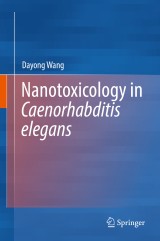Details

Nanotoxicology in Caenorhabditis elegans
|
CHF 189.00 |
|
| Verlag: | Springer |
| Format: | |
| Veröffentl.: | 22.05.2018 |
| ISBN/EAN: | 9789811302336 |
| Sprache: | englisch |
Dieses eBook enthält ein Wasserzeichen.
Beschreibungen
<p></p><p>This book focuses on the toxicity of engineered nanomaterials (ENMs) and their underlying physicochemical, cellular, physiological, and molecular mechanisms. Further, it covers ENMs’ translocation and their targeted organ toxicology, and discusses chemical and pharmacological strategies used to combat nanotoxicity. Engineered nanomaterials (ENMs) are defined as materials with one or more dimensions of less than 100 nm, and have shown considerable promise in several areas of development. At the same time, the potential toxicity of ENMs for human health and environmental organisms is increasingly attracting attention. In addition to the typical properties of model animals, <i>Caenorhabditis elegans </i>is extremely sensitive to environmental toxicants, which makes it the ideal <i>in vivo </i>assay system for toxicological studies. <i>C. elegans </i>has been widely used in toxicity assessment and toxicological studies of environmental toxicants andstresses. This book provides a comprehensive summary of nanotoxicology research on <i>C. elegans</i>. </p><br><p></p>
<p>Values of <i>C. elegans</i> in Toxicological Study.- Endpoints for Toxicity Assessment of Nanomaterials.- Exposure Routes of Nanomaterials.- Toxic Effects of Certain Nanomaterials.- Physicochemical Basis for Nanotoxicity Formation.- Cellular and Physiological Mechanisms of Nanotoxicity Formation.- Molecular Mechanisms of Nanotoxicity Formation.- Distribution and Translocation of Nanomaterials.- Confirmation of Nanomaterials with Low-Toxicity or Non-Toxicity Property.- Surface Chemical Modification to Reduce the Toxicity of Nanomaterials.- Pharmacological Prevention of the Toxicity Induced by Environmental Nanomaterials</p>
<p></p><p>Dr. Dayong Wang is a professor at the Medical School, Southeast University, China. He obtained his Ph.D. from Peking University in 2001 and completed his post-doctoral training at the University of Toronto from 2002 to 2004. His research focuses on toxicology and pathology using <i>Caenorhabditis elegans</i> as a model animal, fields in which he has published more than 160 research articles. </p><br><p></p>
This book focuses on the toxicity of engineered nanomaterials (ENMs) and their underlying physicochemical, cellular, physiological, and molecular mechanisms. Further, it covers ENMs’ translocation and their targeted organ toxicology, and discusses chemical and pharmacological strategies used to combat nanotoxicity. Engineered nanomaterials (ENMs) are defined as materials with one or more dimensions of less than 100 nm, and have shown considerable promise in several areas of development. At the same time, the potential toxicity of ENMs for human health and environmental organisms is increasingly attracting attention. In addition to the typical properties of model animals, <i>Caenorhabditis elegans </i>is extremely sensitive to environmental toxicants, which makes it the ideal <i>in vivo </i>assay system for toxicological studies. <i>C. elegans </i>has been widely used in toxicity assessment and toxicological studies of environmental toxicants and stresses. This book provides a comprehensive summary of nanotoxicology research on <i>C. elegans</i>.<p></p><p></p><div><br></div>
Focusing on the toxicity of engineered nanomaterials (ENMs) and their underlying physicochemical, cellular, physiological, and molecular mechanisms. Discussing chemical and pharmacological strategies used to combat nanotoxicity With ample color figures
Diese Produkte könnten Sie auch interessieren:

Apoptotic Pathways as Targets for Novel Therapies in Cancer and Other Diseases

von: Marek Los, Spencer B. Gibson

CHF 177.00















